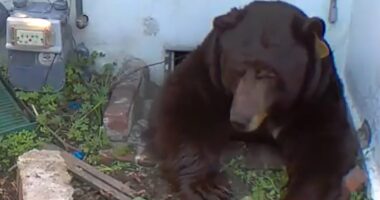Share this @internewscast.com
Scientists have discovered an intriguing behavior in American bison that may indicate significant ecological shifts nationwide.
In a comprehensive six-year study utilizing GPS collars, satellite imagery, and field experiments, researchers found that these majestic creatures are retracing ancient migration routes once traversed by their ancestors before human development altered the landscape.
Experts attribute this return to prehistoric pathways to successful conservation initiatives that have recreated migration-friendly environments and eliminated obstacles. These efforts have enabled bison to heed their natural instincts and environmental signals, guiding them along traditional seasonal routes.
Bison herds move in response to snow patterns, vegetation growth, and water availability, with older animals leading the way and teaching the younger generation the ancestral paths.
The study suggests that by reclaiming these historic trails, bison are playing a crucial role in restoring ecological balance, indicating that America’s landscapes are gradually regaining their natural resilience and rhythms.
Currently, the bison population has stabilized at approximately 5,000 since the mid-2010s, following a dramatic recovery from a mere 23 individuals in 1902. Today, these bison cover about 1,000 miles annually along a 50-mile migration path.
The research also revealed that bison possess remarkable spatial memory, repeatedly returning to the same high-quality grazing areas once barriers are removed.
Bill Hamilton, John T. Perry Jr. Professor of Research Science at Washington and Lee University, said: ‘What we’re witnessing is that as bison move across the landscape, they amplify the nutritional quality and capacity of Yellowstone.’

Over six years, researchers tracked bison with GPS collars, analyzed satellite imagery, and conducted field studies, revealing that the herds are following age-old migration paths once traveled by their ancestors long before human development altered the landscape (stock)
While bison restoration efforts across North America have largely focused on small, managed herds, this research highlighted how large, free-roaming herds reshape landscapes over broad areas.
The team observed bison grazing in Yellowstone’s river valleys during spring and summer.
Although their grazing may appear intense, it actually enhances the nitrogen cycle, enriching the plants they consume.
Soil microbes recycle decaying plants and animals into forms of nitrogen, like ammonium and nitrate, that are readily used by plants.
Grazing bison increase microbial activity, making plants not only as productive as ungrazed areas but up to 150 percent more nutritious, benefiting other herbivores across the park.
‘As bison move across the landscape, they amplify the nutritional quality and capacity of Yellowstone,’ Hamilton said.
‘Their grazing likely has important consequences for other herbivores and for the food web as a whole, similar to the changes that occurred in the Serengeti when the wildebeest population recovered.’
To understand these effects, researchers conducted field experiments from 2015 to 2021, monitoring plant growth, nutrient cycling, soil and plant chemistry, herbivory, plant community composition, and microbial populations.

The research also revealed that bison possess remarkable spatial memory, repeatedly returning to the same high-quality grazing areas once barriers are removed
They used movable enclosures to compare grazed and ungrazed areas and combined these experiments with satellite imagery and GPS tracking to map the bison’s impact across the entire migratory landscape.
The study highlights the critical role of large, free-ranging bison herds in maintaining ecosystem health, suggesting that restoring their ancient migratory patterns could revitalize landscapes across North America, reconnecting wildlife with the natural rhythms that shaped the continent for millennia.
Bison have roamed North America for over 10,000 years, shaping the continent’s grasslands and ecosystems.
Before European colonization, an estimated 30 to 60 million bison ranged across the continent, from Alaska to Mexico and from the Great Plains to the eastern woodlands.
These massive herds played a critical role in maintaining open grasslands, fertilizing the soil, and supporting countless other species.
Native American tribes relied on bison for food, clothing, shelter, tools, and spiritual practices, making the animals central to cultural and social life.
In the 19th century, bison populations plummeted due to overhunting, commercial slaughter and government campaigns aimed at removing them from the Plains. By the 1880s, fewer than 1,000 bison remained in the wild, down from tens of millions just decades earlier.
This near-extinction was catastrophic for both ecosystems and Native American communities, as it disrupted the balance of the Great Plains and eliminated a key food source and cultural resource.
In response, small conservation herds were established in national parks such as Yellowstone and on private ranches in the late 19th and early 20th centuries.
These early efforts prevented the species from going extinct, but the bison were often kept isolated and fenced, preventing them from following their natural migratory routes.
By the mid-20th century, bison populations had slowly grown, but most were still managed for livestock or limited ecological purposes.
















